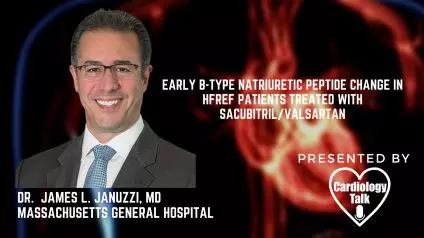Dr. James L. Januzzi, MD- Early B-Type Natriuretic Peptide Change in HFrEF Patients Treated With Sacubitril/Valsartan...
Dr. Jim Januzzi is a member of the Cardiology Division at Massachusetts General Hospital. He is a member of the Harvard Clinical Research Institute's faculty and the Hutter Family Professor of Medicine at Harvard Medical School. Dr. Januzzi graduated from New York Medical College, then completed an internal medicine residency at Brigham and Women's Hospital, followed by a cardiology and echocardiography fellowship at Massachusetts General Hospital. In this video Dr. Januzzi discusses the
Early B-Type Natriuretic Peptide Change in HFrEF Patients Treated With Sacubitril/Valsartan.
Link to Abstract-
https://www.jacc.org/doi/10.1016/j.jchf.2021.09.007
Abstract-
Patients with heart failure with reduced ejection fraction (HFrEF) treated with sacubitril/valsartan (Sac/Val) according to conventional prescribing guidelines had their B-type natriuretic peptide (BNP) levels measured.
Background
Sac/Val may enhance BNP concentrations by inhibiting neprilysin.
Methods
We looked at changes in BNP, N-terminal pro-BNP (NT-proBNP), and urinary cyclic guanosine monophosphate (ucGMP) from baseline to endpoint in an individual patient analysis from the EVALUATE-HF (Study of Effects of Sacubitril/Valsartan vs. Enalapril on Aortic Stiffness in Patients With Mild to Moderate HF With Reduced Ejection Fraction) (
Results
At baseline, week 4, and week 12, the median (interquartile ranges [IQRs]) BNP concentrations were 145 [IQR: 55-329], 136 [IQR: 50-338], and 135 [IQR: 51-299] ng/L, respectively. From baseline to week 4 (0 percent [30 percent to +41 percent]; P = 0.36) or week 12 (+1 percent [36 percent to +50 percent]; P = 0.97), there was no significant difference. By week 12, half of the trial participants had had a decrease in BNP. There was no link between Sac/Val dosage and variations in BNP. Changes in BNP were directly related with changes in NT-proBNP (rho: = 0.81; P 0.001), which reduced by 30% (50%) and 32% (54%) to weeks 4 and 12 (P 0.001 for both). Changes in BNP, on the other hand, were only slightly related to changes in ucGMP (rho: = 0.19; P 0.001). Whether BNP was increased (+57 percent [12 percent to +14 percent]), decreased (+11 percent [34 percent to +115 percent]), or unchanged (+34 percent [15 percent to +205 percent], increases in ucGMP were detected.
Conclusions
There was no significant overall rise in BNP concentrations in this pooled analysis of patients with HFrEF who had typical criteria for Sac/Val medication, and patients showed an increase in ucGMP regardless of the trajectory of BNP change. (EVALUATE-HF; NCT02874794) (Effects of Sacubitril/Valsartan Therapy on Biomarkers, Myocardial Remodeling, and Outcomes [PROVE-HF]; NCT02887183) (Study of Effects of Sacubitril/Valsartan vs. Enalapril on Aortic Stiffness in Patients With Mild to Moderate HF With Reduced Ejection Fraction [
Introduction
Sacubitril/valsartan (Sac/Val) is a neprilysin inhibitor of the angiotensin receptor that helps patients with heart failure with reduced ejection fraction (HFrEF) (1). Increased concentrations of many compensatory compounds may result from neprilysin inhibition; the sum total of increased vasoactive peptides tends to result in vascular dilatation, natriuresis, diuresis, and blood pressure lowering (2). Atrial B-type natriuretic peptides (ANP) and C-type natriuretic peptides (CNP), as well as BNP, are vasoactive targets for neprilysin degradation. ANP and CNP are the ones that neprilysin binds to the most and degrades the most. Neprilysin, on the other hand, binds and destroys BNP with a low avidity (3-5), making BNP changes less predictable. On the one hand, treatment with Sac/Val may cause variable increases in BNP (4); however, no significant increase in BNP was observed in 46 percent of PARADIGM-HF (Prospective Comparison of ARNI with ACEI to Determine Impact on Global Mortality and Morbidity in Heart Failure) participants after treatment with Sac/Val.
It's unclear why BNP levels rise in some individuals during Sac/Val medication, or what clinical factors influence this. The use of anecdotal evidence to verify medicine adherence by monitoring BNP growth is not supported by evidence (6). Furthermore, while it is thought that a rise in BNP may partially mediate the benefit of Sac/Val, it is unknown to what extent changes in BNP correlate with changes in NT-proBNP, which reflects disease status, or the intracellular messenger cyclic guanosine monophosphate (cGMP), which reflects drug effect, during treatment with Sac/Val. Finally, PARADIGM-HF trial participants had to meet stringent inclusion and exclusion criteria, as well as a run-in time with both enalapril and Sac/Val. These factors are likely to have a significant impact on BNP concentrations in the trial population compared to individuals treated in everyday clinical practice who aren't subjected to strict inclusion/exclusion criteria or who are given a run-in period (7). To answer these questions, we used data from the EVALUATE-HF (Effect of Sacubitril-Valsartan vs Enalapril on Aortic Stiffness in HFrEF) trial and the PROVE-HF (Prospective Study of Biomarkers, Symptom Improvement, and Ventricular Remodeling During Entresto Therapy for Heart Failure) studies to pool individual level data from HFrEF patients treated with Sac/Val. Both trials had inclusion/exclusion criteria that were similar to the regulatory approval for clinical practice in the United States, and neither trial had a run-in period; thus, changes in BNP, NT-proBNP, and urinary cyclic guanosine monophosphate (ucGMP) were measured from pretreatment to 4 weeks and 12 weeks during treatment with Sac/Val in a patient population that was more representative of clinical practice.
Methods
an example of the research
Patients with available baseline BNP concentrations from the prospective, observational PROVE-HF study and the randomized, controlled EVALUATE-HF experiment (8) were included (9). Only patients randomized to the Sac/Val treatment arm in EVALUATE-HF were included in this trial, whereas all patients were treated with Sac/Val in PROVE-HF.
The EVALUATE-HF experiment was a multicenter clinical trial that randomly assigned 465 patients to either Sac/Val (24 mg sacubitril and 26 mg valsartan twice daily, with a target dose of 97 mg sacubitril and 103 mg valsartan twice daily) or enalapril therapy. Chronic HF with a history of LVEF 40%, age 50 years, history of hypertension, New York Heart Association (NYHA) functional class I, II, or III, treatment with stable dosages of guideline-directed pharmacological therapy, and systolic blood pressure >105 mm Hg were key inclusion criteria in EVALUATE.
The PROVE-HF study comprised 794 patients aged 18 years with chronic HF with a left ventricular ejection fraction (LVEF) of 40%, NYHA functional class I, II, or III who were started on Sac/Val and titrated to a target dose of 97/103 twice daily.
The study protocol was approved by the relevant institutional review board in both investigations. Prior to enrolment, all participants had to complete an informed consent form.
All EVALUTE-HF patients and a subgroup of PROVE-HF patients had their blood drawn into specialized tubes.
Analyses in the lab
Blood samples were taken by venipuncture at baseline (before exposure to Sac/Val), 4 weeks, and 12 weeks in both experiments. Blood samples were taken in phlebotomy tubes with protease inhibitors in order to analyze labile biomarkers (P100; BD Biosciences). These tubes are coated with K2EDTA anticoagulant and contain a proprietary protease inhibitor cocktail that reduces preanalytical variability by preventing BNP breakdown in vitro (5,10,11). Blood was taken in tubes containing only EDTA to test for NT-proBNP. The Diagnostics BNP assay (Siemens) and the NT-proBNP assay (Siemens) were used to batch test samples at the central laboratory (Clinical Reference Laboratory) (proBNP II; Roche Diagnostics). The central laboratory evaluated ucGMP in spot samples collected at the same time points as blood samples using an enzyme-linked immunosorbent assay from (R&D Systems).
Analytical statistics
BNP, NT-proBNP, and ucGMP median (interquartile range [IQR]) concentrations are reported for the pooled study population and for each study separately. The Wilcoxon matched-pairs signed-rank test was used to compare changes in concentrations. By dividing the concentrations at these time intervals by the baseline concentrations, the change-to-week 4 and change-to-week 12 ratios were computed. Spearman correlation was used to look at the correlations between biomarkers at each visit and the ratios of change. Baseline features are reported as quartiles of baseline BNP concentrations and quartiles of change in BNP from baseline to week 12, and trend across quartiles is evaluated using an analysis of variance (ANOVA), Kruskal-Wallis, or Pearson chi-squared test, as applicable. Age, sex, race, BMI, estimated glomerular filtration rate (eGFR), NYHA functional class, LVEF, systolic blood pressure, heart rate, and prevalent diabetes mellitus, hypertension, and atrial fibril were analyzed in linear regression models with log2-transformed BNP variables as outcome variables and the following a priori selected exposure variables at baseline: age, sex, race, BMI, estimated glomerular filtration rate (eGFR Additional analyses of the effect of dose on changes in BNP and NT-proBNP were carried out by categorizing individuals based on their maximum dose exposure previous to the visit of interest. In the linear regression analysis of independent predictors of BNP, dose was also included as a covariate. STATA version 16.1 was used to conduct the statistical analysis. P values are two-sided, and values greater than 0.05 are considered significant.
Results
Characteristics at the start
BNP was available at baseline in 221 (95%) of the 232 individuals randomized to Sac/Val in EVALUATE-HF. In the PROVE-HF research, 146 patients were included in the labile biomarker substudy and had baseline BNP readings available. PROVE-HF participants were found to have baseline characteristics that were equivalent to the rest of the population (12). The mean SD age of the 367 patients with HFrEF was 66.511.1 years, 273 (74%) were male, 261 (71%) were white, and 334 (91%) were NYHA functional class II or III, according to the study (Table 1). The patients' HF duration was 74.9 78.8 months, their LVEF was 32% 9%, and they were well-treated with guideline-directed medical therapy at the time of enrolment.




